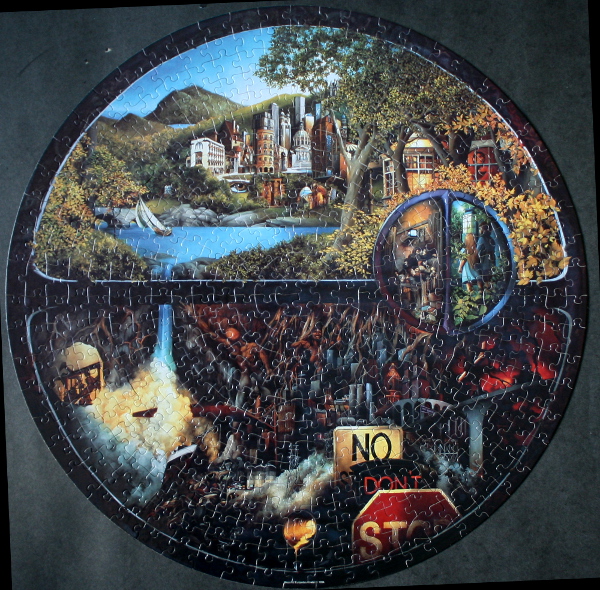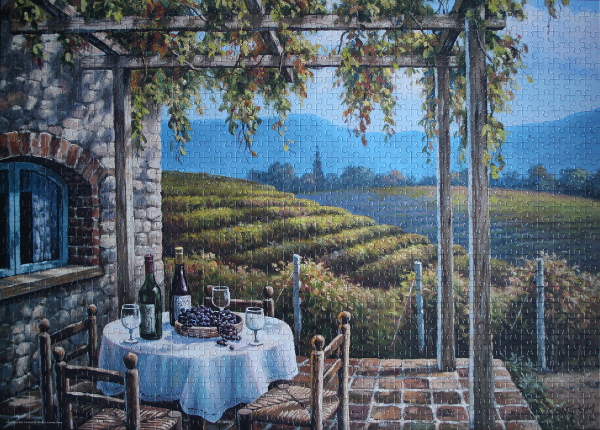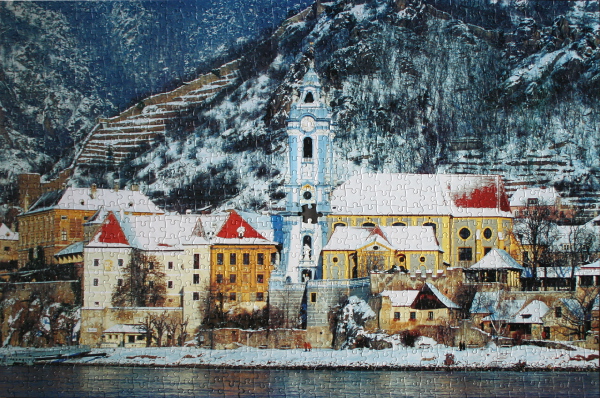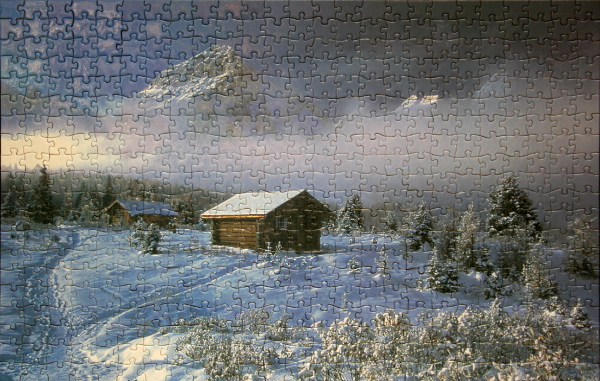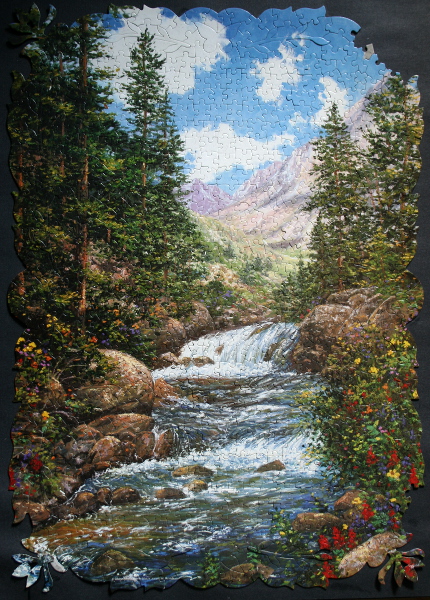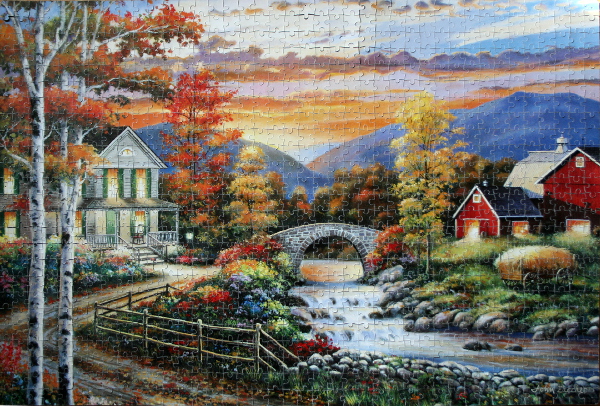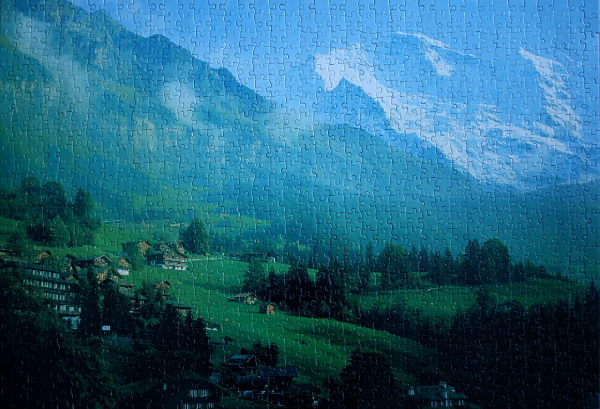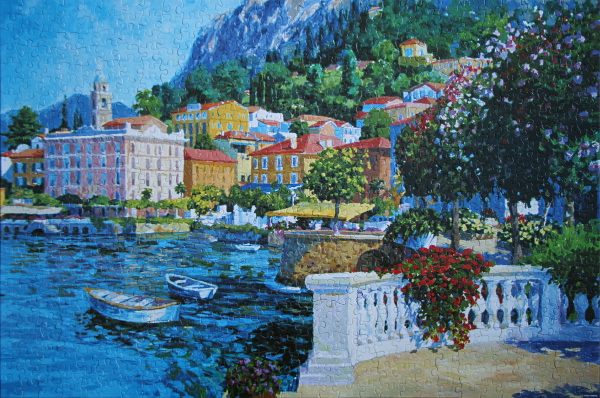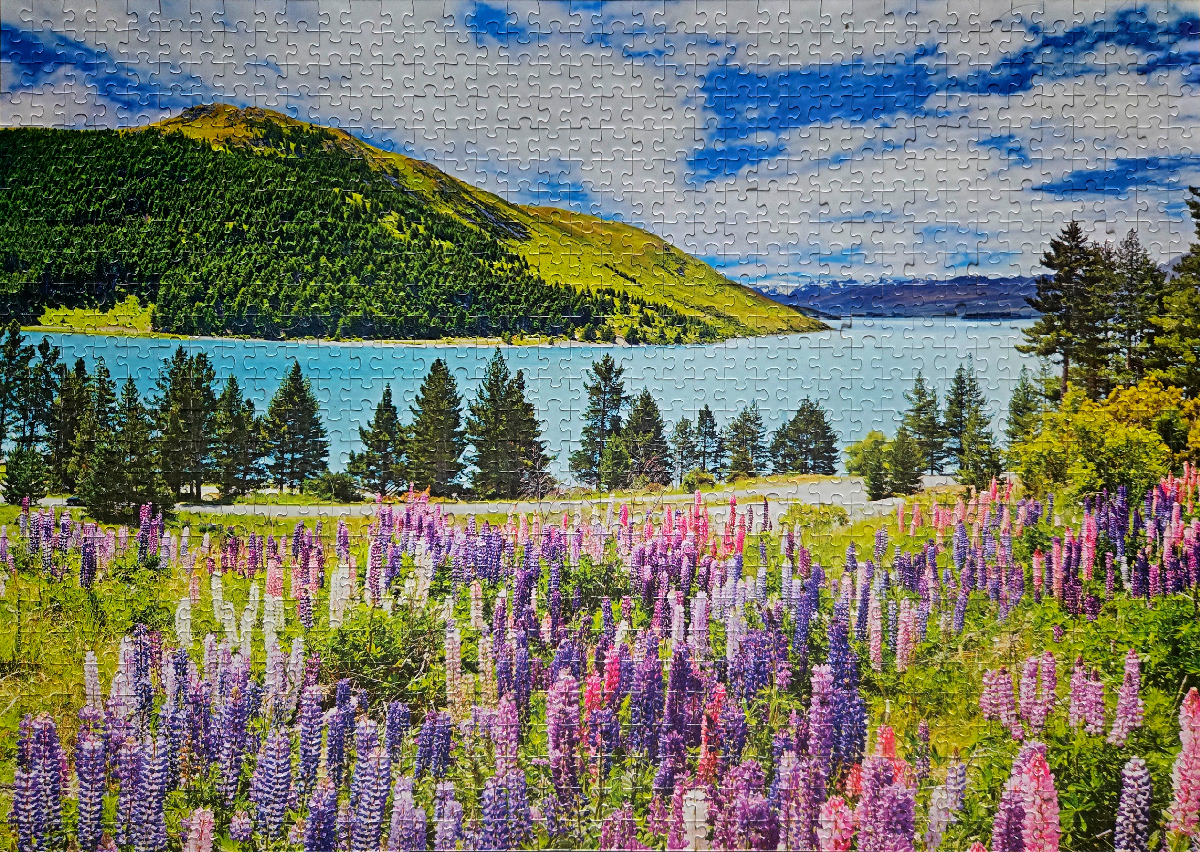
Size: 1000 pieces
Available for purchase on eBay
Dimensions: 48.1 cm x 67.95 cm
Manufacturer: Mega Puzzles, No. 21001ALN, A12073YT
Box: photo
Tag: mountain
Petra, Jordan
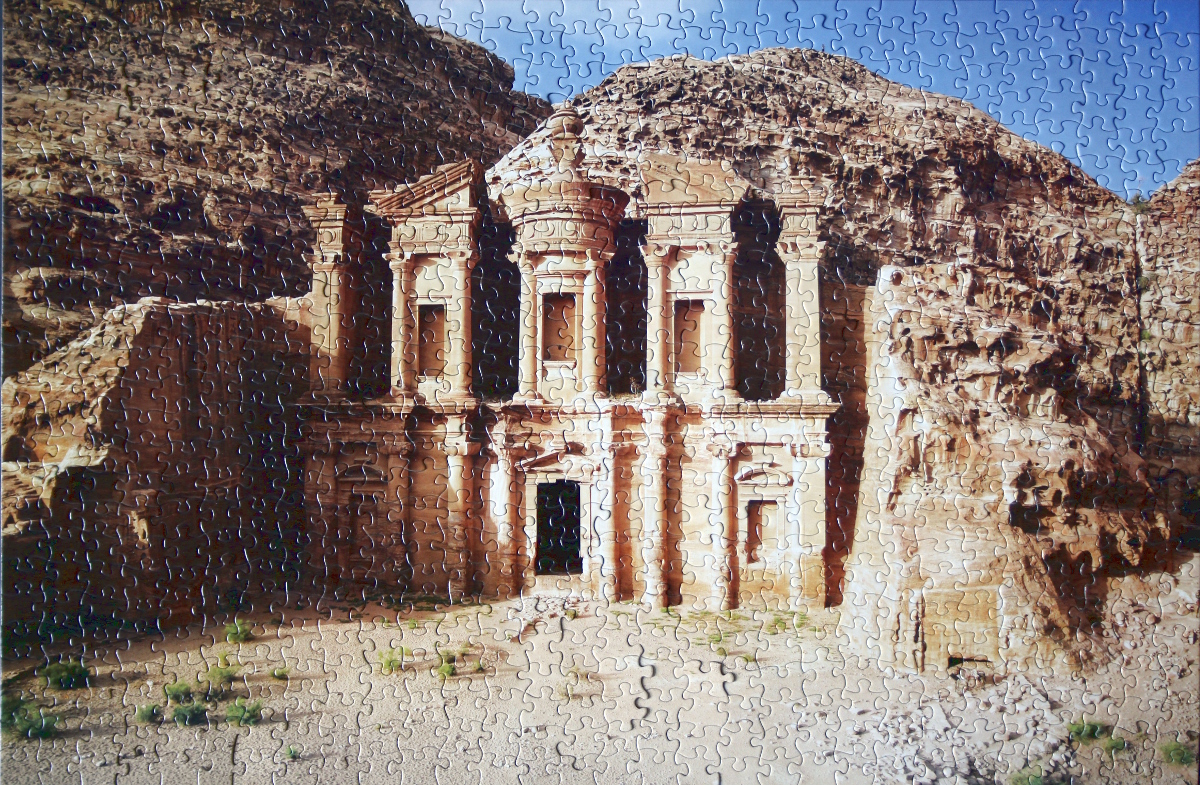
Size: 750 pieces
Available for purchase on eBay
Dimensions: 39.37 cm x 59.69 cm
Manufacturer: The Canadian Group, #42008PAL
Photographer: George Fischer
Box: photo
Santorini, Greece
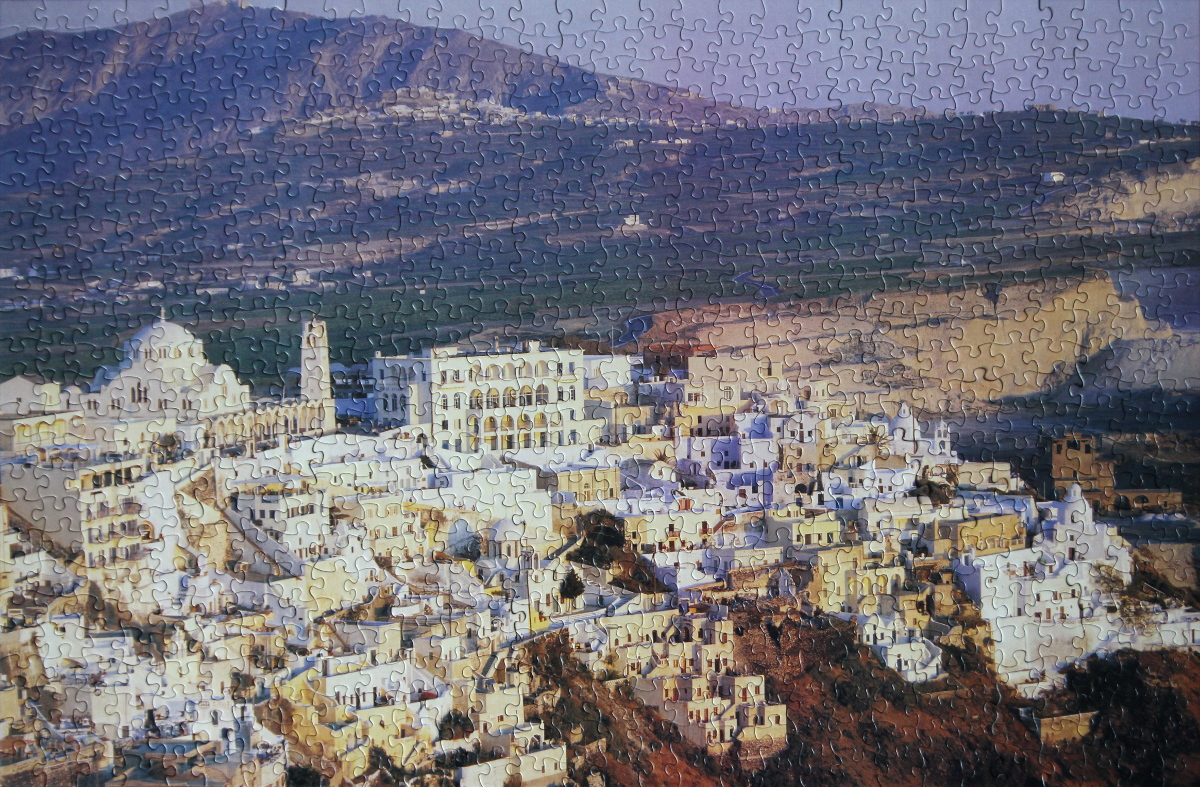
Size: 750 pieces
Available for purchase on eBay
Dimensions: 39.4 cm x 59.7 cm
Manufacturer: The Canadian Group, #40510-31
Box: photo
Autumn mountain
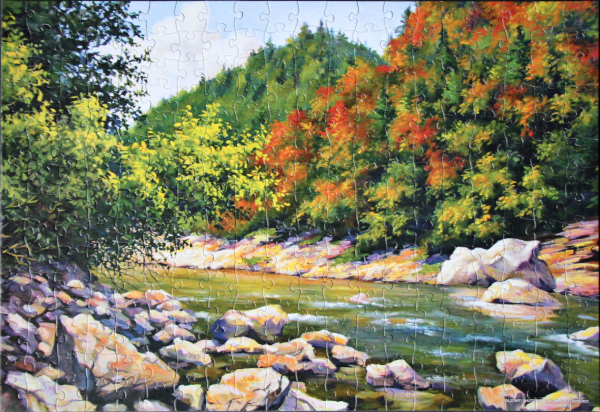
Size: 300 pieces
Available for purchase on eBay
Dimensions: 33.02 cm x 48.26 cm
Manufacturer: The Canadian Group, #03878
Artist: lvl27art
Original: painting
Box: photo
Great ocean road

Size: 1000 pieces
Available for purchase on eBay
Dimensions: 48.26 cm x 68.58 cm
Manufacturer: The Canadian Group, #43445
Photographer: Neale Cousland
Original: photograph
Box: photo
Cinque Terre Splendor
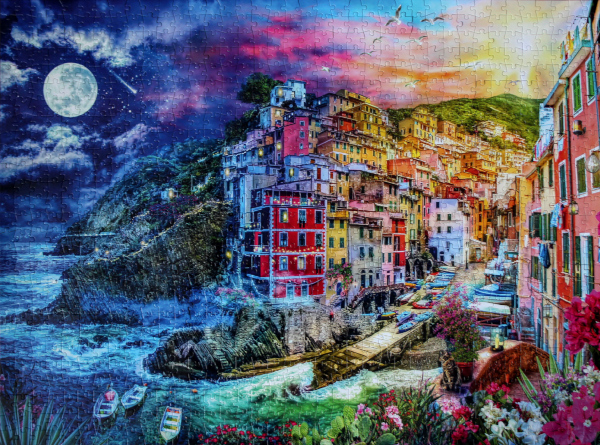
Size: 1000 pieces
Available for purchase on eBay
Dimensions: 50 cm x 68 cm
Manufacturer: Buffalo Games, 11840
Box: photo
Lake District
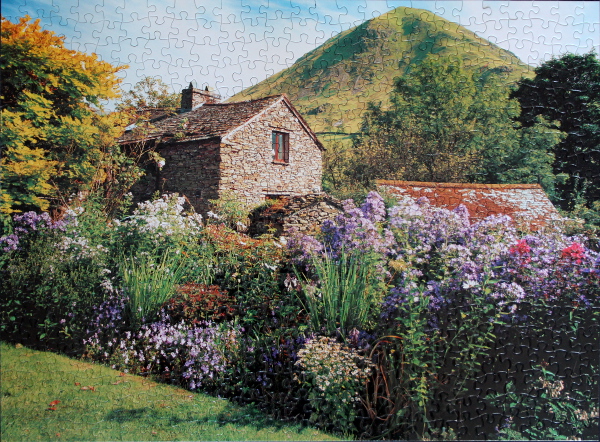
Size: 500 pieces
Dimensions: 48 cm x 36 cm
Manufacturer: TCG, #40275-3
Photographer: David Noble
Original: photograph
Puzzle: Great Britain Cumbria Lake District, National park. Lovely easy-to-assemble puzzle with a serene country-side landscape. Good places to start are the boundaries of grass with flowers and sky with mountain and trees. Distinct textures of the house and a brick-coloured roof, smooth green mountain, orange, yellow, and black tree leaves split the picture into clear regions. The flower bed can be assembled by focusing separately on purple, red, green, and black flowers.
Portugal Azores Islands
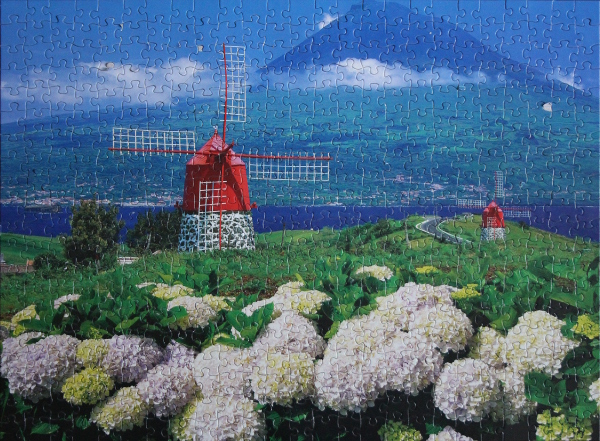
Size: 500 pieces
Dimensions: 48 cm x 36 cm
Manufacturer: TCG, #58805-23
Author: Günter Gräfenhain
Puzzle: Windmills always seem somewhat magical to me – an image from a quiet pastoral fantasy, drowning in luscious flowers, with bottomless blue skies. This puzzle is quite simple due to clear transitions and small number of pieces. I loved letting my mind wander in in its clouds and fields.
There are many good places to start: the bright red of the mills and the white nets of the blades, the boundaries between green and deep blue, the horizon, the mountains and the clouds against the sky. Hydrangeas are probably the most challenging part, but if you’ve filled in everything else, including the black shadows at the bottom, they soon fall into place.
This puzzle came as part of a package of five 500-piece puzzles.
Puzzle: High Sierra Reflections
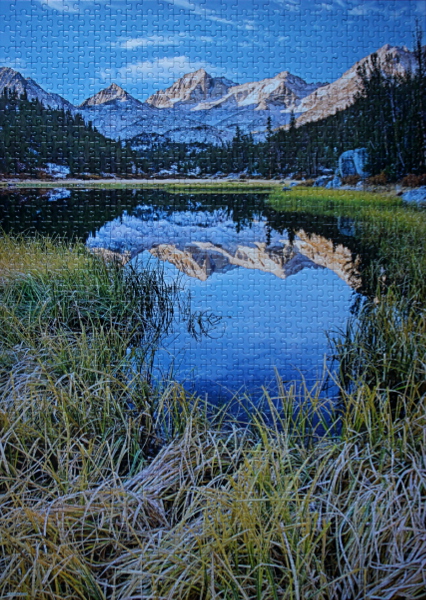 Size: 1000 pieces
Size: 1000 pieces
Dimensions: 48.10cm x 67.95cm
Producer: Mega Brands, Vibrant series, 2013, No. 51420ABN, A28103LP
Photographer: Elizabeth Carmel
Photo: original
Puzzle: A bit on a challenging side, this puzzle benefits from having good lighting and patience. As with most reflection puzzles, it benefits from having the line of the horizon as a horizontal guide, splitting the image into two distinct regions. This line, as well as the borders between the mountain range and the sky, together with its reflection, are good places to start. Another convenient clear border is between the dark evergreen trees and the mountain, again duplicated in the reflection. The bright green patch of the grass on the right, the water, and the sky are the next logical regions to complete, leaving a large are of the grass stalks, which presents the most challenge. Here good lighting, as well as colour and stalk size distinctions are the best helpers.
Notes: As the box does not specify where exactly this photo is taken, I assume that High Sierra refers to a region in the Sierra Nevada mountain range.
It is a mountain range in the western United States, between the Central Valley of California and the Basin and Range Province. The Sierra Nevada has a significant history. The California Gold Rush occurred in the western foothills from 1848 through 1855. Due to inaccessibility, the range was not fully explored until 1912. Today, some mountain passes, such as Duck Pass with obsidian arrowheads, are artifact locations from historic intertribal trade route trails.
The literal translation of Sierra Nevada is “snowy mountains,” from sierra “a range of hills,” 1610s, from Spanish sierra “jagged mountain range,” lit. “saw,” from Latin serra “a saw”; and from fem. of Spanish nevado “snowy.” [Wiki]
Puzzle: Kirwan – Dream of Euripides
Size: 500 pieces
Dimensions: 48.26cm in diameter
Producer: American Publishing & Television, Candu Toy & Sport Co. Inc, 1995, Rose Art Industries, Made in USA, No. 6524 (thank you to PuzzleMan for the producer information)
Artist: Jim Kirwan
Painting: original
Puzzle: A beautiful painting bringing to forefront the issues of ecology, consumerism, and the police state. The artist explores the two sides of the coin: how we see the idyllic society and what it costs in the environmental damage and lack of freedoms.
A fun puzzle to do, not very trivial for a beginner, mostly due to nearly-uniform colouring of the puzzle border pieces, and a large uniformly-patterned area in the bottom half. Easiest places to start are the “no”, “don’t”, and “stop” signs, yellow and blue outburst in the bottom left quarter, the horizontal separating black band between the top and bottom halves, and the smaller circle with two halves. In the top half, the sky and the sea, the sailboat, the tree and mountains bordering on the sky, and the red window are good as starting regions. The yellow leaves and the buildings in the top half and the smoke and brighter red and yellow spots are easy to distinguish. Once all these are in place, the puzzle is small enough to make the rest manageable.
Notes: “The symbol for Ecology was created by Euripides; it was a simple circle with a single horizontal line through the middle. In this version of that idea the world is portrayed in two extremes: in the upper portion of the painting the world seems almost idyllic; proportional; and livable with breathing room, clean water, and real possibilities without apparent limits.
In the lower half, concealed from what we think of as our opportunities; we can see what we have made of that bright vision of that fantasy world above. Pollution, oil pumps, the roots of the world amid the chaos of our failures and the trash we so abundantly produce in mega-volumes. That is what we have allowed ‘the developed world’ to become: A world composed of “NO” and “DON’T” and “STOP.” It is a world without light or grace or freedom of any kind. It is the underbelly of unchecked capitalism as we practice it and as we worship the material- philosophy with an incessant and nearly religious ‘consumerism.'” [Jim Kirwan on Rense.com]
Puzzle: Vineyard Terrace by Sung Kim
Size: 1000 pieces
Dimensions: 67.9 cm x 48.1 cm
Producer: Mega Puzzles, The Art of Sung Kim series
Artist: Sung Kim – Born in 1940 in Seoul, South Korea, Sung Kim exhibited his artistic talents early in childhood. He entered and won various art contests and decided to pursue his passion for art by attending Seorabol Art College where he graduated with honors. Sung opened his own studio and worked as an illustrator for various magazines and children’s books. He traveled throughout Europe before immigrating to the United States in 1980. For the past 20 years, Sung has worked with various fine art galleries, producing over 400 original landscape paintings, and has sold his paintings to people from all over the world. [Puzzle box]
Painting: original
Puzzle: There is a wonderful book by Gerald Durrell called “My Family and Other Animals”, in which he describes life in Corfu – a Greek island to which his mother and three siblings have moved when he was 10. As a child, he explores the island gathering various animals (he has been an enthusiastic budding zoologist at that age), against the backdrop of the slow-paced life of the adults on the island. The olive trees, the sea, the tranquility of sunny afternoons, and the overall calm of the Mediterranean is what I remember vividly from the book. And this puzzle by Sung Kim carries that same quiet feeling of a light breeze on a vine-shaded terrace, on a lazy sunny afternoon somewhere in the Mediterranean.
This puzzle is not a trivial one to assemble, as uniform patterns such as leaves at the top, trees in the background, and bricks of the terrace take up large regions. It is a very calming scene, however, so I have found it quite relaxing, so I did not mind slightly longer time to find the pieces I needed. There are a few good regions to start: the boundary of the sky and the mountain, as well as the borders of the mountain and the trees, and far away trees and the fields. The table with white tablecloth, and the wine glasses and bottles is also easy to assemble. The window with surrounding bricks, and the chairs are also a different enough shade and pattern to not be difficult. The terrace frame is a little harder to complete, but when done it can serve as horizontal and vertical guides for the res of the puzzle. The lighter bricks of the wall are sufficiently different from the tiles of the floor. The leaves at the top can be fitted in between the horizontal guides of the terrace frame, and the rest of the puzzle comes together afterwards.
The assembly went very well with a glass of wine and the early spring sun coming in through the window, promising warm afternoons, if not in the Mediterranean.
Puzzle: Glimmer
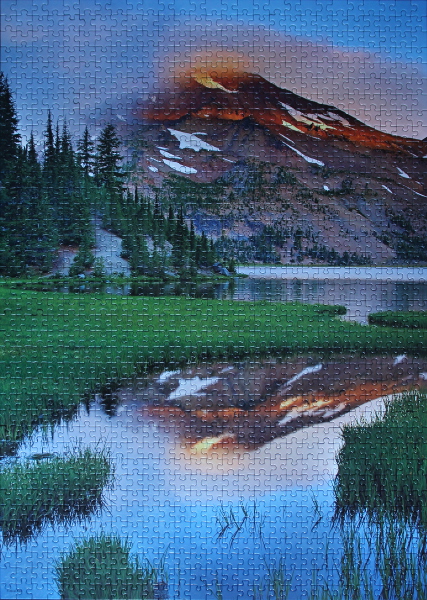
Size: 1000 pieces
Dimensions: 67.95 cm x 48.1 cm
Producer: Mega Puzzles, Vibrant series, 2013, No. 51420AAN, A 29073LP
Artist: Adrian Klein
Original: photo
Puzzle: This puzzle takes a little time, but reflections are easy to do, and the vibrant colours and well-fitting pieces make this puzzle a pleasure to assemble. The easiest regions to start are the top of the mountain and its border with the sky, and the mountain’s reflection and its border with the river water. The blue of the sky and the river water, as well as the white of the river near the horizon can be put together next. The green grass in the middle and the horizontal white line serve as horizontal guides along which the mountain bottom and the evergreens can then be completed. The grass islands on the river and the remaining mountain pieces fall into place easily after that.
Notes: The sunrise light glimmers briefly on the summit of South Sister in Three Sisters Wilderness. [Adrian Klein site]
Puzzle: Dürnstein, Austria
Size: 1000 pieces, 1 missing
Dimensions: 73 cm x 48.57 cm
Producer: Sure-Lox, The Canadian Group
Puzzle: Not a completely trivial puzzle to complete, due to the snow and trees on the mountains forming a somewhat-uniform pattern. It is simple to start from the more prominent regions, such as the bright buildings, the river/snow border, the snow on the roofs, and the steps going up into the mountains. Once that is done, the top mountain range is separated into mostly blue and mostly black regions, and the central blue tower serves as a vertical guide to assist the completion. The Sure-Lox pieces fit together well and simplify the process that would have been harder with more loosely-fitting pieces.
Notes: Dürnstein is a small town on the Danube river in the Krems-Land district, in the Austrian state of Lower Austria. It is one of the most visited tourist destinations in the Wachau region and also a well-known wine growing area.
The town gained its name from the medieval castle, Burgruine Dürnstein, which overlooked it. The castle was called “Duerrstein” or “Dürrstein”, from the German duerr/dürr meaning “dry” and Stein, “stone”. The castle was dry because it was situated on a rocky hill, high above the damp conditions of the Danube at the base of the hill, and it was built of stone. [Wiki]
Puzzle: Winter
Size: 500 pieces
Dimensions: 43 cm x 27.5 cm
Producer: I no longer have the box for this puzzle, so I would much appreciate any information on its name and maker.
Puzzle: Not a hard puzzle to do, since even with its similar colours it’s rather small and the pieces are distinct. Good places to start are the mountain/sky border, the houses, and the brighter patches of the sky and the snow. The rest takes a bit more time, but is quite pleasant to assemble as the pieces fit together well.
Puzzle: Forces of Time
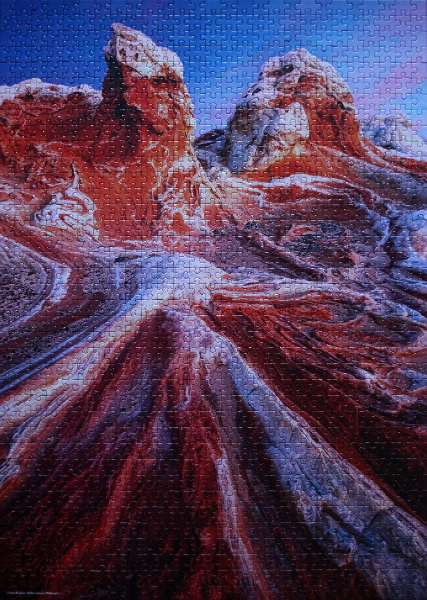
Size: 1000 pieces
Dimensions: 67.95 cm x 48.1 cm
Producer: Mega Puzzles, Vibrant series, 2013, No. 51420AAN, A29073LP
Artist: Sean Bagshaw
Original: photo
Puzzle: Not a completely trivial puzzle, but due to its vibrant colours and the pieces fitting together well, it makes for an extended pleasure to assemble. The easiest region to start is the border between the rock and the sky. Sky can be completed next. The uniform areas of orange, red, and dark red can be done next. The white/blue diagonal ridges serve as guidelines, along which various layers can then be assembled. A serene puzzle to do with a good audiobook.
Notes: Sandstone layers form intricate and alien patterns of color and texture in the Vermilion Cliffs National Monument, Arizona. [Outdoor Exposure Photography site]
Puzzle: Mountain River
Size: 750 pieces
Dimensions: 48.1cm x 64.8cm
Producer: RoseArt, Borders series
Notes: I’m missing the box for this puzzle and am unable to find the real name of it. If you have that information, could you please let me know?
Puzzle: A beautiful puzzle from the Borders series (there is also the Aspen Fantasy one), unfortunately due to being quite old in my collection, it is missing a corner. Flowers in the bottom right, the river, the larger rocks, and the sky are good places to start the assembly. The mountains and the fields in the background can follow, leaving the trees framing the picture. Not a trivial puzzle due to variety of piece shapes and small detail, but very pleasant on the eye.
Puzzle: Rural Countryside by John Zaccheo
Size: 1000 pieces
Dimensions: 45.4 cm x 67.31 cm
Producer: Wrebbit, Perfalock series, # 20076, 2005
Note: I do not have the box anymore, and thus not sure who the artist is. If you have that information, please let me know.
Puzzle: A pleasant and easy puzzle to complete. The good regions to start are the sky (lots of horizontal guides there), the mountains, the tall red and yellow trees, the bridge, the river, the buildings, the birch trees, the cart with the hay, and the fence along the road. From that point on, the remaining pieces should fall into place easily.
Puzzle: Banff National Park, Alberta, Canada
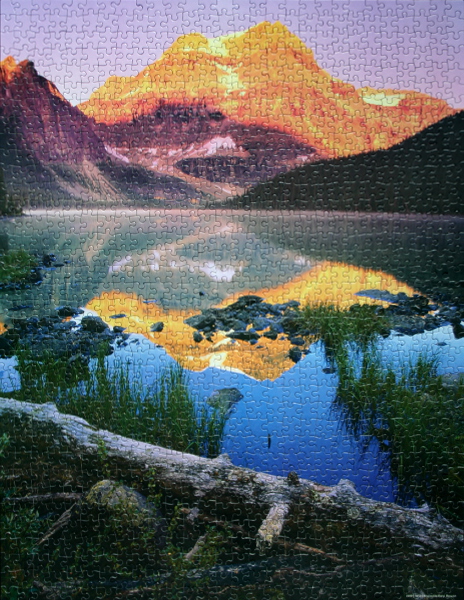
Size: 1000 pieces
Dimensions: 51.12 cm x 66.52 cm
Producer: Big Ben, MB Puzzles, Hasbro, 2007, 04962-N03
Puzzle: Beautiful serene puzzle to make. Despite its size, the assembly flows smoothly due to distinct separate regions of colour separated by clear borders. The lavender of the sky, the yellow, purple, and black mountains, their clearly separated reflections and the horizontal divide of the water edge are a breeze to put together. The blue of the water, the rock regions, the green grass patches, and the guide made by the log, let the rest of the pieces fall into place.
Notes: Banff National Park is located in the province of Alberta in the Canadian Rocky Mountains. In the fall of 1883, three Canadian Pacific Railway construction workers stumbled across a cave containing hot springs on the eastern slopes of Alberta’s Rocky Mountains. From that humble beginning was born Banff National Park, Canada’s first national park and the world’s third. Spanning 6,641 square kilometres of valleys, mountains, glaciers, forests, meadows and rivers, Banff National Park is one of the world’s premier destination spots. [Banff National Park site]
Puzzle: Swiss Alps
Size: 1000 pieces
Dimensions: 73 cm x 48.57 cm
Producer: Sure-Lox, The Canadian Group
Notes: Beautiful landscape, very serene to make. Not completely trivial due to large regions of similar colours, but with Sure-Lox pieces fitting well together, still a pleasure to do. Starting with the grass regions is easiest, filling in the houses, and then dealing with the boundary regions between mountains, the ice, and the sky, provides enough guides to fill in the remainder of the pieces.
Puzzle: Bellagio by Julian Askins
Size: 750 pieces
Dimensions: 59.7 cm x 39.4 cm
Producer: Sure-Lox
Artist: Julian Askins
Notes: Beautiful zen-inducing puzzle with its bright colours and serene scenery. The easiest places to start are the solid colour areas of the sky, the patio with the colonnade, the mountain/sky border, and the blue of the water. The houses can also be assembled easily, guided by the colour contrast and vertical separators. The red flowers and the bright rounded tree with its base can follow, and the rest of the pieces fall into place after.






